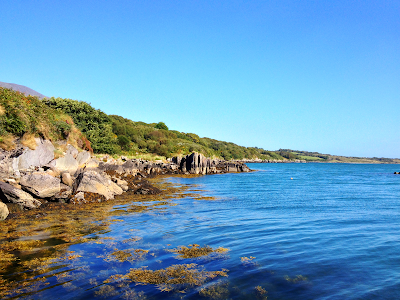The entire biosphere is largely dependent on plants and algae for food and oxygen, yet land plants did not evolve until about 450 million years ago.
We have algae and seaweeds in every ocean on Earth ranging in colour from red to green to brown to black.
Yet, going back 2 billion years, Earth had no green plants at all in oceans. The ubiquitous green seaweeds we see today had their start around a billion years ago, entering the fossil record as tiny seaweeds living in shallow seas. These first micro-fossil-seaweeds, a form of algae known as Protoerocladus antiquus, are barely visible to the naked eye, measuring a wee 2 millimetres. They look a bit like tiny shoelaces curled in a loose bundle.
Seaweed grows along rocky shorelines around the world, but it is most commonly eaten in the Asian countries of Japan, Korea and China — though countries like Ireland are starting to get on the seaweed bandwagon. I have a jar of crushed Japanese seaweed sold commercially as a superfood and suggested additive for increasing the nutrition of meals while adding a salty, umami flavour. Globally, we consume nearly 30 million tonnes of these ocean vegetables.
Seaweed contains a wide range of vitamins and minerals — vitamin A (beta carotene), vitamin C, iodine, potassium, magnesium, iron, calcium and vitamin B12. It is also a prized vegan source of omega-3 fats, though as a Norwegian omnivore I prefer mine from northern fish oils. While seaweed does contain all that goodness, these aquatic veggies also like to soak up metals and metalloids, and by ingesting them (or soaking in them) we absorb those nasties as they like to lodge in our fatty tissues and internal organs. Some, such as Cadmium (Cd), Mercury (Hg) and Lead (Pb) can be toxic at even trace levels.
 |
| West Cork, Ireland |
Stinky, but relaxing and an Irish tradition that has gone on for centuries. The environmental conditions in which the Irish seaweeds are collected offers some protection over the risk of absorbing heavy metals in those salty viscous baths.
The term includes some types of Rhodophyta (red), Phaeophyta (brown) and Chlorophyta (green) macroalgae. Seaweed species such as kelps provide essential nursery habitat for fisheries and other marine species and thus protect food sources; other species, such as planktonic algae, play a vital role in capturing carbon, producing up to 90% of Earth's oxygen. Understanding these roles offers principles for conservation and sustainable use as this planet evolves forward.
References: Tang, Q., Pang, K., Yuan, X. et al. A one-billion-year-old multicellular chlorophyte. Nat Ecol Evol, 2020 DOI: 10.1038/s41559-020-1122-9

